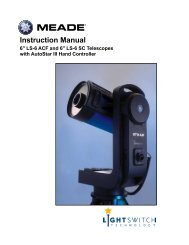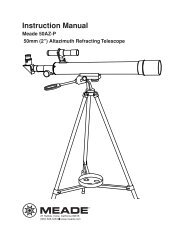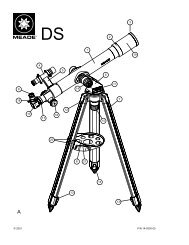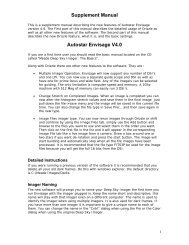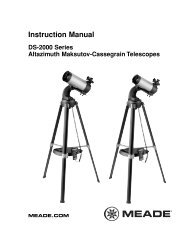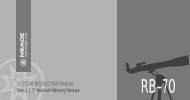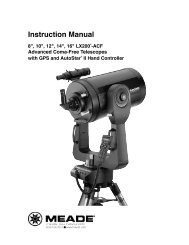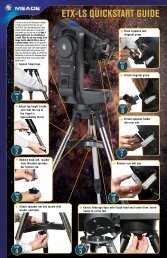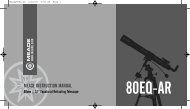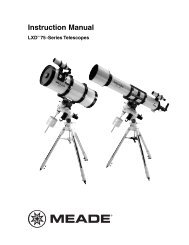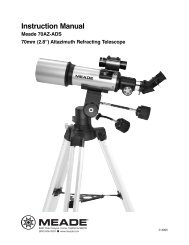Model 114EQ-ASTR - Meade
Model 114EQ-ASTR - Meade
Model 114EQ-ASTR - Meade
You also want an ePaper? Increase the reach of your titles
YUMPU automatically turns print PDFs into web optimized ePapers that Google loves.
<strong>Meade</strong><strong>114EQ</strong><strong>ASTR</strong> 3/28/07 9:33 AM Page 11<br />
or skyscraper make excellent targets. Point<br />
the optical tube so it lines up with your<br />
object. Objects will appear upside down and<br />
backwards in this model telescope.<br />
Unlock the lock knobs: To move the<br />
telescope, you will need to unlock the Right<br />
Ascension (3, Fig. 5) and Declination (4, Fig.<br />
5) lock knobs (just rotate to unlock or lock;<br />
when locking, only tighten to a “firm feel,” do<br />
not overtighten).<br />
Use the red dot viewfinder: If you have not<br />
done so, align the viewfinder (22) with the<br />
telescope’s eyepiece (17) as described earlier.<br />
Look through the red dot viewfinder until you<br />
Just below the constellation Orion’s<br />
famous belt of three stars (in the<br />
middle of his sword), is The Great<br />
Orion Nebula. This wonderful<br />
telescope target is really a cosmic<br />
star factory where a glowing<br />
gas cloud surrounds hot<br />
young stars.<br />
can see the object. It will be easier to locate<br />
an object using the red dot viewfinder rather<br />
than locating with the eyepiece. Line up the<br />
object using the viewfinders red dot.<br />
Look through the eyepiece: Once you have<br />
the object lined up in the viewfinder, look<br />
through the optical tube’s eyepiece. If you<br />
have aligned your viewfinder, you will you see<br />
the object in your eyepiece.<br />
Focus: Look through the eyepiece<br />
and practice focusing on the object you<br />
have chosen.<br />
Try out the slow-motion flexible cable<br />
control: Practice using the right ascension<br />
control cable (3) and declination control<br />
cable (4) to move the telescope. These can<br />
come in very handy, especially when you wish<br />
to move the telescope in very small (fine<br />
control) steps.<br />
Observe the Moon: When you feel<br />
comfortable with the viewfinder, the<br />
eyepieces, the locks and the adjustment<br />
controls, you will be ready to try out the<br />
telescope at night. The Moon is the best<br />
object to observe the first time you<br />
go out at night. Pick a night when the<br />
Moon is a crescent. No shadows are<br />
seen during a full Moon, making it<br />
appear flat and uninteresting. 9<br />
Look for different features on the<br />
Moon. The most obvious features are<br />
craters. In fact you can see craters within<br />
craters. Some craters have bright lines<br />
about them. These are called rays and are<br />
the result of material thrown out of the<br />
crater when it was struck by a colliding<br />
object. The dark areas on the Moon are<br />
called maria and are composed of lava from<br />
the period when the Moon still had volcanic<br />
activity. You can also see mountain ranges<br />
and fault lines on the Moon.<br />
SURF THE WEB<br />
• The <strong>Meade</strong> 4M Community:<br />
http://www.meade4m.org<br />
• Sky & Telescope:<br />
http://www.skyandtelescope.com<br />
• Astronomy:<br />
http://www.astronomy.com<br />
• Astronomy Picture of the Day:<br />
http://antwrp.gsfc.nasa.goc/apod<br />
• Photographic Atlas of the Moon:<br />
http://www.lpi.ursa.edu/research/lunar_orbiter<br />
• Hubble Space Telescope Public Pictures:<br />
http://oposite.stsci.edu/pubinfo/pictures.html<br />
Looking at or near the Sun will cause irreversible damage to your eye. Do not point this telescope at or near the Sun. Do not look through the telescope as it is moving.




